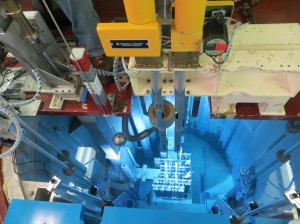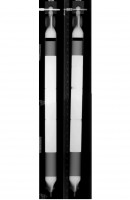Scientists Develop 3-D ‘X-ray’ for Nuclear Fuel
Dentists who want to see what is happening behind your teeth, enamel and gums can capture a complete set of dental X-rays in just a few minutes. But imagine if it took 252 films to get the complete picture.

Looking down into the Neutron Radiography Reactor tank.
That's how many images were required for a full picture of nuclear fuel recently obtained at Idaho National Laboratory's (INL) Hot Fuel Examination Facility (HFEF). The project - the biggest of its kind so far - examined fuel hidden inside its protective metal shell, or cladding. A small reactor called the Neutron Radiography Reactor (NRAD) is used to take these images at many different angles to better understand what is going on inside the fuel.
"When combined with HFEF, NRAD is an invaluable tool in identifying the big-picture impacts of irradiation on nuclear fuel, and then identifying those areas that scientists wish to inspect on the atomic level with more precise instruments," said Mark Henry, INL's director of post irradiation examination.
For this recent project, the neutron radiography team captured 42 images at three different elevations over a three-week period to get a full image of the entire fuel element. The images are used to reconstruct a 3-D tomographic model - a type of reconstruction that pieces together images of sections, similar to what Google Earth does.
The resulting 3-D model is just one part of a process for examining fuel irradiated in INL's Advanced Test Reactor. This type of "non-destructive" examination doesn't damage or change the fuel in any way, just as an X-ray or MRI allows doctors a look inside without putting patients under the knife. While other fuel examinations involve cutting or sectioning fuel into smaller pieces for microscopes, the NRAD exam helps scientists get a good initial look before possibly altering the freshly irradiated state.
Dentists and doctors scrutinize X-rays to look for weak spots in enamel or fractured bones. Similarly, areas of irradiated fuel might be of interest to scientists due to changes in structure. Another aspect they inspect is the minuscule gaps between the fuel plates, which allow them to remain cool. Scientists study fuel gaps looking for changes in size and shape to ensure the fuel retains the needed geometric stability. A cool-able geometry is eventually necessary to pass qualifications and for the fuel to perform properly.
Tomographic reconstruction with NRAD makes it possible for these gaps to be measured before cutting or disassembly is required for further testing. Non-destructive examination is especially important because disassembly may relieve internal stresses, deforming the fuel and skewing the fuel gaps further.

A photo of fuel pins.

A radiograph of the same fuel pins.
Unlike a routine dental appointment, a neutron radiography campaign can take weeks. The recent three-week campaign completed by INL's Post Irradiation Examination Division was groundbreaking. In obtaining these 126 images, the team doubled previous daily production levels, increasing exposures from seven to 14 per day. Not only did the team capture the clearest images ever, but the effort also represented the largest single NRAD imaging campaign to date.
"This is just one example of the valuable results NRAD is capable of," HFEF Nuclear Facility Manager, Rick Gunderson said. "I look forward to leading the collaboration of many more."
A number of HFEF upgrades were required to improve capabilities and complete these fuel examinations. For example, HFEF personnel installed a custom-rotating carrier that lines up with the NRAD neutron beam, which plays the part of the X-ray. The custom, INL-designed carrier holds the irradiated fuel and executes precise rotations.
Scientists can further analyze fuel assemblies with the completed tomographic reconstructions. Just as dentists may point out weak enamel that might need extra care, nuclear fuel examinations and analyses can help scientists improve fuel performance by modifying materials and designs. Better fuels will help keep nuclear workers and communities safe, and provide cheaper electric power.
That's why U.S. Department of Energy research capabilities, such as NRAD, are so important for the nation. Henry reported, "The latest NRAD improvements, made possible through a DOE nuclear energy investment, have provided state-of-the-art reactor control and radiography systems which will provide invaluable information to fuels and materials development researchers over the next 50 years."
 Nora Heikkinen is a communications specialist at Idaho National Lab's Materials and Fuels Complex.
Nora Heikkinen is a communications specialist at Idaho National Lab's Materials and Fuels Complex.

